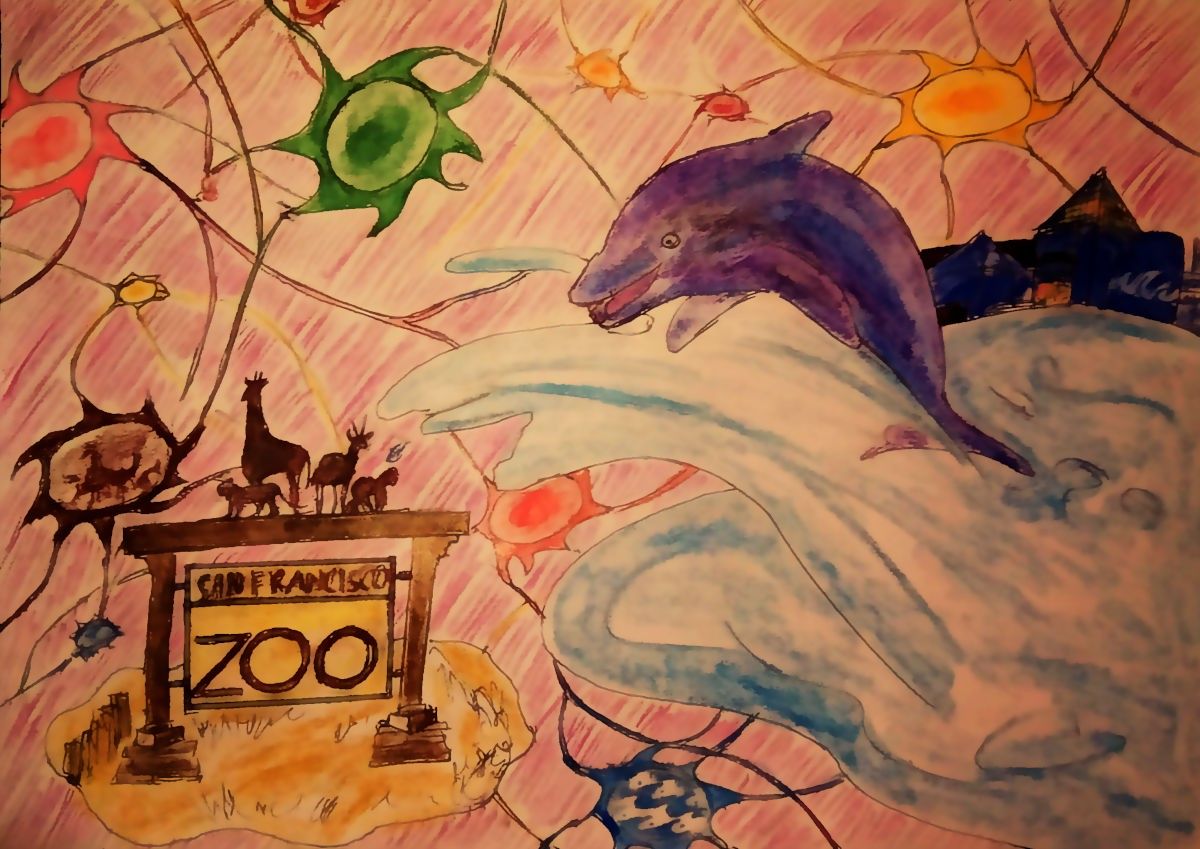True or False
On the malleable nature of memory

On the malleable nature of memory
For a long time, I held a very vivid memory in my mind of petting a dolphin at the San Francisco zoo when I was ten years old. Each time I brought this scene to mind, it seemed as though the memory became clearer and more vivid.
I remember wearing a sweatshirt my mother had bought for me at the beginning of our visit. I remember that it was summer but unseasonably cool outside. I remember the distinct fishy aromas of the marine habitat, competing for space in my mind with the smell of eucalyptus and images of the sunset over the Golden Gate bridge.
It was quite recently that a pang of nostalgia drove me to Google, to find out if there were still bottlenose dolphins at the San Francisco Zoo that I might be able to visit now, and to reconstruct that day after a gap of some 25 years.
Quickly I found a major fault with my plan: there were no bottlenose dolphins at the San Francisco Zoo — and in fact — there never had been. A bit more investigative Googling led me to the startling realization that I’d been telling myself a lie about my childhood for years.
Somehow, in the synaptic hedge maze of my earliest and almost-forgotten experiences, that trip to the San Francisco Zoo my family had taken the summer after I turned 10 had crossed paths with an earlier trip to the Baltimore Aquarium; 2500 miles across the country and 3 years in the past. Because I remembered small details (the new-fabric smell of the sweatshirt, the chilly San Francisco mist that greeted us in the morning), I’d convinced myself of the truth of the bigger picture.
Surprisingly, these tiny details are actually some of the most mutable elements of the mind’s eye-view of our own personal histories.
Take, for example, a classic study about a hot air balloon ride that never happened. Researchers gathered together a group of students and showed them photos of themselves as children. Some of these photos were snapshots of real memories. One of them though, was doctored to make it look as though they’d gone on a hot air balloon ride as a small child when no such trip had taken place.
Amazingly, many of the participants were able to conjure rich details of this imaginary event, and even reacted with disbelief when they were told the photos were fake — convinced for a moment that they actually could remember the whole day of the balloon ride.
A pleasant memory of a day out on a hot air balloon ride can plausibly fit into our own stories about ourselves if we can recall similar events or people to give it more weight in our minds. Like a recurring dream, if we revisit the false memory often enough it feels familiar and we might even fall for our own deception.
Another study demonstrated the remarkable ease with which our brains will take up stray bits of information and tack them to the storyboards of our identities.
Here, psychologists gathered a group of undergraduates and told them they were taking part in a study of food preference and personality. In fact, they wanted to see if a simple suggestion, “you loved eating cooked asparagus as a child,” could sway their preferences in spite of the fact that this wasn’t true.
Many of the students not only seemed susceptible to the nudge, but their psyches latched on to this false bit of biographical data and ran with it, coaxing them to claim that they’d be more likely to order asparagus in a restaurant and even pay more for it at the grocery store.
The brain’s uncanny ability to embroider these false truths into vivid new personal narratives recruits the talents of synaptic actors far and wide across the brain.
When we first experience something new, neurons fire in specific patterns and set to work stringing together new proteins to hold these new patterns in place. This initial imprinting process is called consolidation, and whenever we remember an event or perform a task again, these links become flexible and open to modification.
This is how learning proceeds — it’s a dynamic state that invites change but also opens these networks of nerve cells to new influences that might not be related to the task at hand. As it turns out, the molecular marks left by what we’ve experienced and what we’ve only imagined are strikingly similar.
In one study, a group of researchers planted false memories into the brains of mice using a protein that can be used as a molecular light switch for neurons, allowing researchers to turn on specific nerve cells by briefly exposing them to different wavelengths of light.
First, they let mice explore a new place they’d never visited before, and tracked the neurons that fired while they looked around. These were the neurons that they’d tagged with the light-sensitive proteins — so that they could turn them on by flashing light at them — amounting for the mouse to a mental experience of the real thing.
Then, they set the mice loose in a totally different environment and gave them mild, startling foot shocks that caused them to freeze, a typical mouse’s response to a fearful event. The trick though, was that at the same time, they activated the set of cells that had first fired when the mice explored the old environment, where they hadn’t been shocked and so had no reason to behave fearfully there.
Yet, after these place-specific neurons were activated while the mice were stressed, they began to freeze when they were placed in the original, stress-free environment.
This experiment showed that there were highly specific mental maps for different places within the hippocampus, and that merely engaging the neurons — that kept track of specific places at the same time as a stressful event occurred in real-time — could form a link between the two in the mouse’s mind.
Think of it this way: you go for a hike in the woods and you discover a waterfall, so you decide to go for a swim. It was such a lovely day that you revisit it in your mind often, even days later.
Later in the week, you’re driving to work, thinking of how much you’d rather be at your new favorite hiking spot, when the car behind you runs a stop sign and hits you, jolting you back to the present moment.
Now, the next time you go back to the waterfall for a relaxing day trip, you can’t shake the anxious feeling of the fender bender. And from now on in your memory, instead of a pleasant day, you feel uneasiness, even though the two events had nothing to do with each other in real life.
There’s evidence to suggest that our unremarkable memories are more pliable than ones that were highly emotionally charged. In one study, people were asked to summon either neutral, positive, or negative memories, and then memorize a story.
Instead of looking at the recall ability of the participants for the story they’d just memorized, however, the researchers were instead interested in their memories. If the participants had recalled highly emotional experiences, their memories of these same experiences were undisturbed by the memorization task. The neutral memories, however, proved more changeable before and after the distracting task.
Emotion is a powerful memory glue, and this is why trauma is so hard to overcome.
But the same processes that allow us to re-experience the past also open a window for us to change our perceptions of those events in the present, offering hope for conditions like PTSD, addiction, certain phobias, and anything where our molecular learning and memory sentinels are on high alert.
Drugs that block activity in the amygdala, a strong emotional center in the brain — or that prevent the formation of those synaptic proteins that help to scaffold our memories as we learn new things and recreate them in our minds when we remember them — can also tone down the extreme fear or emotional reactions experienced by those with PTSD if they’re given as a person reimagines traumatic experiences.
Remarkably, distracting behaviors seem to work the same way, derailing the train of neural activity that delivers those old memories so potently and driving it onto the tracks of new experiences, gradually decoupling the extreme emotional surges from the memories of those events.
Neuroscientists think a big part of this effect is the fact that your brain is built for self-fulfilling prophecies. Once you learn a pattern of behavior and the outcome it corresponds to, whether that relationship is positive or negative, you’re primed to expect similar outcomes in similar situations.
Many in the field think that the entire basis of learning is the mistakes our brains make when we do something and receive an outcome we didn’t expect; they call this phenomenon “reward prediction error”.
Let’s go back to our memory of a nice sunny hike that’s been sullied by the unpleasant experience of a fender bender. We might feel anxiety going for that same hike again if we associate it with another bad memory. But gradually — the more we expect to feel bad but instead are pleasantly surprised by the initial unpolluted feelings of relaxation and calm the experience brought us the first time around — our fear memories can be erased.
And we’ll soon be more inclined to go exploring further afield, because we expect only pleasant experiences.
We have a tendency to seek out facts that can anchor us in an objective reality. But just as the very act of observing the natural world alters what’s observed, our memories are transformed each time we return to them.
It might be disorienting to know that our memories aren’t a reliable record of events as they happened, but it’s also a hopeful testament to our capacity for change. Each minor revision of the past gives us an opportunity to update our own ideas about ourselves, and to change our minds about where we’d like to go in the future.
